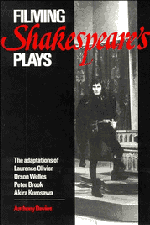 Filming Shakespeare's Plays
Filming Shakespeare's Plays Book contents
- Frontmatter
- Contents
- List of illustrations
- Preface
- Acknowledgements
- Introduction
- 1 Theatrical and cinematic space
- 2 Laurence Olivier's HENRY V
- 3 Laurence Olivier's HAMLET
- 4 Laurence Olivier's RICHARD III
- 5 Orson Welles's MACBETH
- 6 Orson Welles's OTHELLO
- 7 Orson Welles's CHIMES AT MIDNIGHT
- 8 Peter Brook's KING LEAR and Akira Kurosawa's THRONE OF BLOOD
- 9 The film actor
- Conclusion
- Notes
- Select filmography
- Bibliography
- Index
1 - Theatrical and cinematic space
Published online by Cambridge University Press: 01 June 2011
- Frontmatter
- Contents
- List of illustrations
- Preface
- Acknowledgements
- Introduction
- 1 Theatrical and cinematic space
- 2 Laurence Olivier's HENRY V
- 3 Laurence Olivier's HAMLET
- 4 Laurence Olivier's RICHARD III
- 5 Orson Welles's MACBETH
- 6 Orson Welles's OTHELLO
- 7 Orson Welles's CHIMES AT MIDNIGHT
- 8 Peter Brook's KING LEAR and Akira Kurosawa's THRONE OF BLOOD
- 9 The film actor
- Conclusion
- Notes
- Select filmography
- Bibliography
- Index
Summary
The temptation and the tendency to judge Shakespearean film in terms of some sort of theatrical achievement stems partly from that critical tendency to impose old criteria on new artistic fields, partly from the appearance on the screen of established stage actors in Shakespearean roles and partly from a persistent belief – which intelligent criticism has done little to shift – that cinema is really ‘canned’ and transportable theatre. The uncertainty about just what Shakespearean film ought to strive to accomplish will no doubt continue unless there is an attempt to discern clearly the subtle and significant differences which distinguish the two media in their presentation of dramatic material. They are differences which do not merely concern the mode of the work's presentation, but they crucially modify the relationship between the audience and the presented work. It is in the complex field of spatial relationships that the essential distinctions lie.
In his major essays on theatre and cinema, André Bazin writes helpfully and with profound insight on the complex relationship between these two arts, and points with precision to the distinguishing dramatic essence of film. The resonance of Bazin's observations continues to make them seminal in any discussion of the different kinds of space which the stage and screen constitute and his formulations will therefore play a major part in this chapter.
- Type
- Chapter
- Information
- Filming Shakespeare's PlaysThe Adaptations of Laurence Olivier, Orson Welles, Peter Brook and Akira Kurosawa, pp. 5 - 25Publisher: Cambridge University PressPrint publication year: 1988


